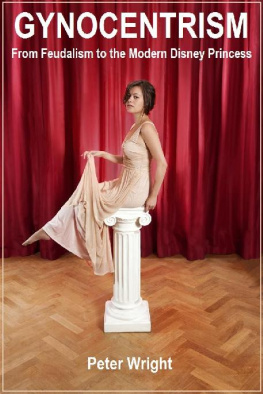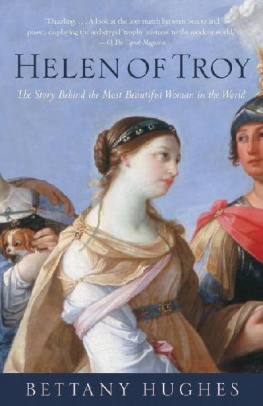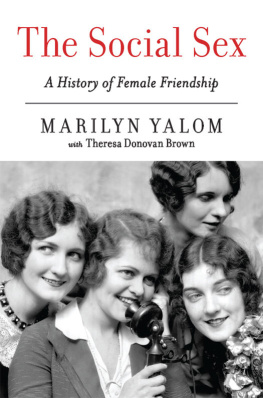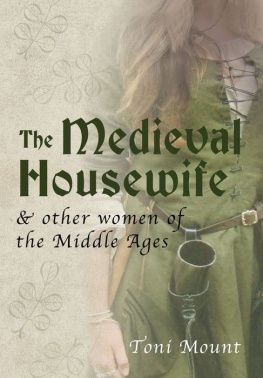Gynocentrism, a centuries old term, refers to the principle of female centeredness or female dominance in various social or interpersonal contexts.
The term has recently enjoyed a resurgence, serving again as a descriptor of the expanding yet centuries old obsession with the rights, status, and power of women. This book traces the history of that tradition to its roots in medieval society, while being careful to note the difference between benign gynocentric acts and the more problematic examples of gynocentric culture.
The essays collected in this volume were originally penned as separate pieces for the website Gynocentrism and its Cultural Origins , and have since been revised for this eBook edition. There are several repetitions of comments and quotes for which I apologize and ask the readers grace they are integral to the structure of the articles and for that purpose have been retained. Chapter 13 Gynocentrism And The Golden Uterus, which discusses biological theories related to gynocentrism, was written by Peter Ryan who has generously given permission for it to be published in this volume.
The essays are grouped into nine parts exploring various aspects of gynocentrism, and providing examples of the phenomenon from historical literature. The final part, Post Gynocentric Relationships explores the possibility of relationships built on the notion of friendship as an alternative to neurotic shibboleths of romantic love.
Peter Wright, August 2014.
- Introduction to Gynocentrism

Gynocentrism n. (Greek, , female Latin centrum , centred ) refers to a dominant or exclusive focus on women in theory or practice; or to the advocacy of this. Anything can be considered gynocentric (Adj.) when it is concerned exclusively with a female (or specifically a feminist) point of view.
Introduction
Cultural gynocentrism arose in Medieval Europe during a period cross-cultural influences and momentous changes in gendered customs. Beginning in around the 12th century European society birthed an intersection of Arabic practices of female worship, aristocratic courting trends, the Marian cult, along with the imperial patronage of Eleanor of Aquitaine and her daughter Marie De Champagne who together crafted the military notion of chivalry into a notion of servicing ladies, a practice otherwise known as courtly love.
Courtly love was enacted by minstrels, playrights and troubadours, and especially via hired romance-writers like Chrtien de Troyes and Andreas Capellanus who laid down a model of romantic fiction that is still the biggest grossing genre of literature today. That confluence of factors generated the cultural conventions that continue to drive gynocentrism today.
Gynocentrism as a cultural phenomenon
The primary elements of gynocentric culture, as we experience it today, are derived from practices originating in medieval society such as feudalism, chivalry and courtly love that continue to inform contemporary society in subtle ways. Such gynocentric patters constitute a sexual feudalism, as attested by female writers like Lucrezia Marinella who in 1600 AD recounted that women of lower socioeconomic classes were treated as superiors by men who acted as servants or beasts born to serve them, or by Modesta Pozzo who in 1590 wrote;
dont we see that mens rightful task is to go out to work and wear themselves out trying to accumulate wealth, as though they were our factors or stewards, so that we can remain at home like the lady of the house directing their work and enjoying the profit of their labors? That, if you like, is the reason why men are naturally stronger and more robust than us they need to be, so they can put up with the hard labor they must endure in our service.
The golden casket above depicting scenes of servile behaviour toward women were typical of courtly love culture of the Middle Ages. Such objects were given to women as gifts by men seeking to impress. Note the woman standing with hands on hips in a position of authority, and the man being led around by a neck halter, his hands clasped in a position of subservience.
Its clear that much of what we today call gynocentrism was invented in the Middle Ages with the cultural practices of romantic chivalry and courtly love. In 12th century Europe, feudalism served as the basis for a new model for love in which men were to play the role of vassal to women who played the role of an idealized Lord. C.S. Lewis, back in the middle of the 20th Century, referred to this historical revolution as the feudalisation of love, and stated that it has left no corner of our ethics, our imagination, or our daily life untouched. Compared with this revolution, states Lewis, the Renaissance is a mere ripple on the surface of literature. Lewis further states;
Everyone has heard of courtly love, and everyone knows it appeared quite suddenly at the end of the eleventh century at Languedoc. The sentiment, of course, is love, but love of a highly specialized sort, whose characteristics may be enumerated as Humility, Courtesy, and the Religion of Love. The lover is always abject. Obedience to his ladys lightest wish, however whimsical, and silent acquiescence in her rebukes, however unjust, are the only virtues he dares to claim. Here is a service of love closely modelled on the service which a feudal vassal owes to his lord. The lover is the ladys man. He addresses her as midons , which etymologically represents not my lady but my lord. The whole attitude has been rightly described as a feudalisation of love. This solemn amatory ritual is felt to be part and parcel of the courtly life.
With the advent of (initially courtly) women being elevated to the position of Lord in intimate relationships, and with this general sentiment diffusing to the masses and across much of the world today, we are justified in talking of a gynocentric cultural complex that affects, among other things, relationships between men and women. Further, unless evidence of widespread gynocentric culture can be found prior to the Middle Ages, then gynocentrism is precisely 800 years old. In order to determine if this thesis is valid we need to look further at what we mean by gynocentrism.
The term gynocentrism has been in circulation since the 1800s, with the general definition being focused on women; concerned with only women. From this definition we see that gynocentrism could refer to any female-centered practice, or to a single gynocentric act carried out by one individual. There is nothing inherently wrong with a gynocentric act (eg. celebrating Mothers Day) , or for that matter an androcentric act (celebrating Fathers Day). However when a given act becomes instituted in the culture to the exclusion of other acts we are then dealing with a hegemonic custom i.e. such is the relationship custom of elevating women to the position of mens social, moral or spiritual superiors.
Author of Gynocentrism Theory Adam Kostakis has attempted to expand the definition of gynocentrism to refer to male sacrifice for the benefit of women and the deference of men to women, and he concludes; Gynocentrism, whether it went by the name honor, nobility, chivalry, or feminism, its essence has gone unchanged. It remains a peculiarly male duty to help the women onto the lifeboats, while the men themselves face a certain and icy death.
While we can agree with Kostakis descriptions of assumed male duty, the phrase gynocentric culture more accurately carries his intention than gynocentrism alone. Thus when used alone in the context of this book gynocentrism refers to part or all of gynocentric culture, which is defined here as any culture instituting rules for gender relationships that benefit females at the expense of males across a broad range of measures.











